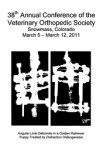Objective: To evaluate the tensile strength and biomechanical properties of the tension band wire technique using a ring pin in a canine patellar transverse fracture model and to compare it with conventional tension band wire techniques.
Methods: The patella with adjacent structures were harvested from 11 adult canine cadavers and osteotomized transversely. The tension band wiring technique with a single Kirschner wire and metal wire was applied to the KM group (n = 7). The KS group (n = 7) was stabilized with the same technique as the KM group, but a nonabsorbable polyethylene orthopedic suture was used instead of metal wire. The RS group (n = 7) was stabilized with the combination of a ring pin and an orthopedic suture. A single axial tensile force was loaded to the specimens, and the loads at 1-, 2-, and 3-mm displacement and the maximum failure loads were measured.
Results: The mean weight of canine cadavers was 13.7 kg (11.3 to 17.4 kg), and a total of 21 pelvic limbs were used. The RS group showed significantly greater strength compared to the KM group and KS group at maximum failure loads and compared to the KM group at 2- and 3-mm displacement.
Conclusions: The tension band wire technique with a ring pin withstands greater force compared to conventional methods in the canine transverse patellar fractures.
Clinical relevance: The ring pin can be considered a viable option for fractures in dogs primarily requiring resistance to tensile forces.









